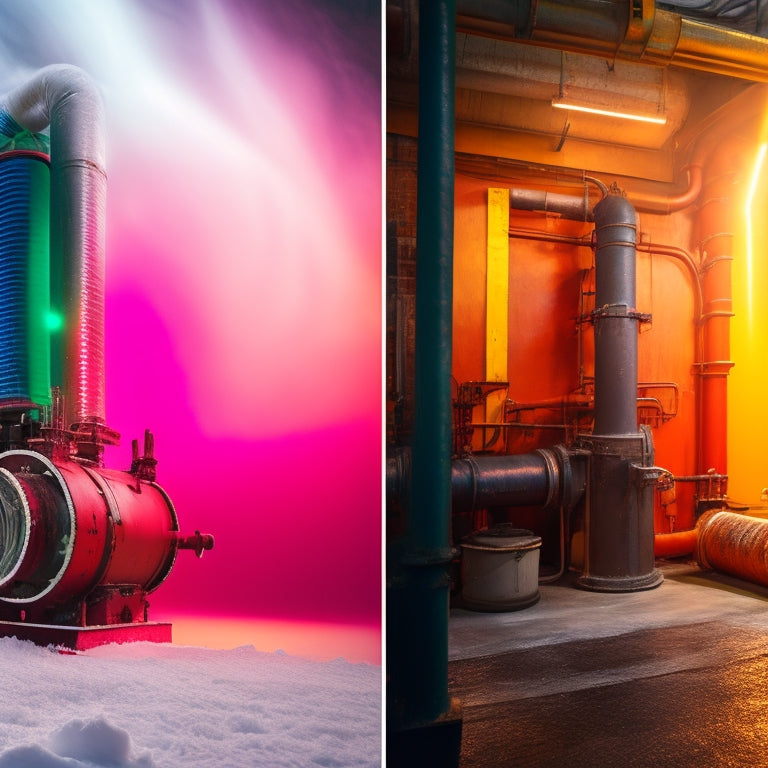
What Pipe Insulation Products Lower Energy Bills?
Share
You can effectively lower your energy bills by selecting from a range of pipe insulation products that provide high thermal resistance, reduce heat loss, and retain heat generated by your heating systems. Fiberglass, foam, and reflective pipe insulation products are popular options that can help you achieve significant energy savings. Mineral wool, rigid foam, and cellular glass insulation are also viable alternatives, each with their unique benefits and applications. By choosing the right pipe insulation product for your specific needs, you'll not only reduce energy losses but also take the first step towards a more efficient and cost-effective heating system - and the possibilities don't end there.
Key Takeaways
- Fiberglass pipe insulation reduces heat transfer effectively, enhancing energy efficiency and lowering energy bills.
- Foam pipe insulation can save up to 40% on energy costs by minimizing heat loss in unheated areas like basements and garages.
- Rigid foam insulation types, such as foam board and polyisocyanurate insulation, provide long-term, high-performance insulation for pipes, leading to energy savings.
- Spray foam insulation offers high energy efficiency and cost savings, making it an effective solution for pipes exposed to extreme temperatures.
- Reflective pipe insulation products, like reflective foil and fiberglass with reflective coating, minimize radiative heat transfer, resulting in lower energy bills.
Fiberglass Pipe Insulation Benefits
When considering pipe insulation products, you likely want to know the benefits of choosing fiberglass pipe insulation. This type of insulation offers high thermal resistance, making it an effective choice for reducing heat transfer.
Fiberglass pipe insulation is also easy to install, with various application techniques available, including wrapping, snapping, and sliding. You can choose from different insulation types, such as pre-molded, molded, and flexible fiberglass, each suited for specific pipe sizes and configurations.
Additionally, fiberglass pipe insulation is durable, resistant to corrosion, and can withstand extreme temperatures. By incorporating renewable energy solutions into your fleet operations, you can further reduce energy losses and optimize energy efficiency.
Similarly, investing in energy storage systems can decrease reliance on fossil fuels and provide backup power during outages. By selecting fiberglass pipe insulation, you can optimize your energy efficiency, reduce energy losses, and enjoy the freedom to focus on other aspects of your life.
Foam Pipe Insulation Savings
When you choose foam pipe insulation, you'll reap significant benefits.
By reducing heat loss, you'll cut energy costs and enhance thermal resistance, resulting in a more efficient system.
Additionally, incorporating renewable energy sources, such as solar-powered fast charging, can further reduce your carbon footprint.
You'll notice these advantages firsthand, as foam insulation helps you optimize your piping setup.
Reduced Heat Loss
You can considerably reduce heat loss in your pipes by using foam pipe insulation, resulting in substantial energy savings.
When pipes aren't insulated, heat escapes, causing your heating system to work harder and increasing your energy bills.
Furthermore, incorporating renewable energy sources like solar power sustainable electrification can further reduce your carbon footprint and energy consumption.
By installing foam pipe insulation, you can minimize heat loss and maintain a consistent temperature. This is especially important in unheated areas like basements, crawlspaces, and garages.
Foam pipe insulation is an effective solution as it provides a high level of thermal resistance, reducing heat transfer and keeping your pipes warm.
Energy Cost Cutting
By insulating your pipes with foam, you'll reap significant energy cost savings. This energy-saving strategy is a vital aspect of effective cost management.
When your pipes are insulated, the heat generated by your heating system is retained, reducing the energy required to warm your home or building.
Implementing time-of-use rate strategies for cost-effective charging, as seen in time-of-use rates, can also contribute to energy cost savings.
Additionally, reducing peak demand by 10 kW could save up to $1,200 annually, as highlighted in energy management and demand charges. This, in turn, lowers your energy bills.
With foam pipe insulation, you can expect to save up to 40% on your energy costs.
By investing in this simple yet effective solution, you'll be taking a significant step towards achieving energy independence and reducing your reliance on external energy sources.
Thermal Resistance Boost
The thermal resistance of foam pipe insulation plays an essential role in reducing heat loss and conserving energy. As you select insulation materials, consider the thermal conductivity comparison to guarantee peak performance.
In addition, adopting energy-efficient solutions like electric vehicles, which offer lower operating costs, can further reduce energy expenses. Furthermore, the reduced greenhouse gas emissions from EVs can also contribute to a cleaner environment.
-
Reduced heat loss: Foam pipe insulation's high thermal resistance minimizes heat transfer, resulting in significant energy savings.
-
Improved system efficiency: By reducing heat loss, your piping system operates more efficiently, reducing energy costs and environmental impact.
-
Increased freedom from energy waste: With foam pipe insulation, you can enjoy the freedom to allocate resources elsewhere, knowing your energy bills are under control.
Reflective Pipe Insulation Efficiency
Efficiency is the driving force behind the widespread adoption of reflective pipe insulation in modern industrial settings. You're likely drawn to this technology because it reduces energy losses and saves you money. Reflective pipe insulation products work by minimizing radiative heat transfer with their reflective surfaces. This results in lower energy bills and a more sustainable operation.
| Insulation Materials | Thermal Resistance (R-value) | Installation Ease |
|---|---|---|
| Reflective Foil | R-4 to R-6 | Easy to wrap around pipes |
| Fiberglass with Reflective Coating | R-3 to R-5 | Requires more effort, but durable |
| Radiant Barrier Insulation | R-2 to R-4 | Most difficult to install, but high performance |
Mineral Wool Insulation Options
Across various industrial applications, you're likely to encounter mineral wool insulation options as a popular alternative to reflective pipe insulation products.
Mineral wool benefits include its high temperature resistance, making it ideal for high-heat processes. Additionally, it's a cost-effective solution that provides reliable insulation performance.
Here are three key insulation applications where mineral wool excels:
-
High-temperature piping: Mineral wool's heat resistance makes it perfect for insulating pipes carrying hot fluids or gases.
-
Industrial equipment: It's often used to insulate equipment such as boilers, furnaces, and heat exchangers.
-
HVAC systems: Mineral wool insulation helps reduce energy losses in heating, ventilation, and air conditioning systems.
Pipe Wrap Insulation Solutions
When you choose pipe wrap insulation solutions, you'll find they're easy to install, reducing the hassle and complexity associated with other insulation methods.
By wrapping pipes with insulation, you'll greatly reduce heat loss, resulting in energy savings and a more efficient system.
As a cost-effective solution, pipe wrap insulation is an attractive option for those looking to minimize expenses while still achieving reliable performance.
Easy to Install
Wrap pipe insulation solutions around your pipes to reduce heat loss and energy consumption.
You'll appreciate the ease of installation, which allows you to take control of your energy bills. With DIY installation, you can get started right away.
Here are three benefits of easy-to-install pipe wrap insulation solutions:
-
Fast and Simple: Most products require no special tools or training, making it easy to get the job done quickly.
-
Flexible Insulation Materials: Choose from a variety of insulation materials, such as foam, fiberglass, or reflective insulation, to suit your specific needs.
-
Customizable Fit: Pipe wrap insulation solutions come in various sizes and can be easily cut to fit your pipes, ensuring a snug and secure fit.
Reduces Heat Loss
Heat loss through uninsulated pipes can be significant, especially in unheated areas like basements, crawlspaces, or outdoor pipes.
You'll want to reduce heat loss to lower your energy bills and conserve natural resources.
Pipe wrap insulation solutions are effective in reducing heat loss. By wrapping insulation materials around your pipes, you'll improve heat retention and minimize energy loss.
This is especially important for pipes carrying hot water, as they're more prone to heat loss.
With proper pipe insulation, you'll enjoy lower energy bills and a more efficient heating system.
Cost-Effective Solution
By choosing pipe wrap insulation solutions, you're not only reducing heat loss but also opting for a cost-effective way to maintain your pipes.
This approach is particularly beneficial for those seeking freedom from high energy bills. With pipe wrap insulation, you can enjoy significant savings without breaking the bank.
Here are three reasons why pipe wrap insulation is a cost-effective solution:
-
Affordable materials: Pipe wrap insulation is made from affordable materials that won't dent your wallet.
-
Easy installation: The DIY-friendly design of pipe wrap insulation means you can install it yourself, saving on labor costs.
-
Sustainable options: Many pipe wrap insulation products are made from sustainable materials, reducing your environmental footprint while keeping your pipes warm.
Spray Foam Insulation Methods
You're likely familiar with the concept of spray foam insulation, but have you evaluated the various methods involved in applying this type of insulation to pipes?
When it comes to spray foam insulation methods, there are several techniques to evaluate. The most common is the open-cell spray application, which involves spraying the foam directly onto the pipe surface. This method allows for a high level of insulation thickness, making it effective for pipes in extreme temperatures.
Another method is the closed-cell spray application, which provides a more durable and water-resistant barrier. Both methods require specialized equipment and training, but offer a high level of energy efficiency and cost savings.
Rigid Foam Insulation Types
You'll find two primary types of rigid foam insulation: foam board insulation and polyisocyanurate insulation.
Foam board insulation is a cost-effective option, often used in residential applications, while polyisocyanurate insulation offers higher thermal resistance and is typically used in commercial or industrial settings.
Both types are designed to provide long-term, high-performance insulation for pipes.
Foam Board Insulation
Three types of foam board insulation are commonly used in pipe insulation applications: extruded polystyrene foam (XPS), polyisocyanurate (PIR), and polyurethane (PUR).
You'll find these foam boards in various thicknesses, from 1/4 inch to 2 inches, and in different sizes to fit specific pipe diameters.
-
Foam board advantages: They provide high R-values, are durable, and resistant to moisture and mold growth.
-
Foam board applications: You can use them in both new construction and retrofit projects, on pipes in unheated areas like basements, crawlspaces, and outdoors.
-
Energy efficiency: By installing foam board insulation, you can reduce heat loss, lower your energy bills, and enjoy a more comfortable and energy-efficient home.
When selecting a foam board insulation, consider factors like R-value, cost, and ease of installation to guarantee you get the best product for your specific needs.
Polyisocyanurate Insulation
Polyisocyanurate insulation, a type of rigid foam insulation, offers a high R-value per inch of thickness, making it an effective choice for insulating pipes in various applications. You can use it in both new and retrofit projects, including industrial, commercial, and residential buildings.
| Polyisocyanurate Applications | Thermal Performance |
|---|---|
| Industrial piping | Up to R-6.5 per inch |
| Commercial HVAC systems | Up to R-6.2 per inch |
| Residential plumbing | Up to R-6.0 per inch |
| Refrigeration systems | Up to R-6.8 per inch |
| Cryogenic systems | Up to R-7.0 per inch |
With its high R-value and versatility, polyisocyanurate insulation is an excellent option for reducing energy losses and improving thermal performance in your piping systems.
Cellular Glass Insulation Systems
Cellular glass insulation systems offer a unique combination of properties that make them an attractive choice for pipe insulation applications.
You benefit from their high compressive strength, low thermal conductivity, and corrosion resistance. These cellular properties guarantee that your pipes remain well-protected and energy-efficient.
Here are three key advantages of cellular glass insulation systems:
-
High-temperature resistance: They can withstand extreme temperatures, making them ideal for high-heat applications.
-
Water resistance: Their closed-cell structure prevents water from penetrating the insulation, reducing the risk of corrosion and damage.
-
Low maintenance: Cellular glass insulation systems are durable and long-lasting, requiring minimal upkeep and replacement.
Ceramic Blanket Insulation Uses
You'll find ceramic blanket insulation useful in a variety of applications where high-temperature resistance and thermal shock tolerance are essential.
This type of insulation is ideal for ceramic applications that involve extreme temperatures, such as in furnaces, boilers, and heat exchangers.
Ceramic blanket insulation has a low thermal conductivity, which means it's effective at reducing heat transfer and energy loss. Its high-temperature resistance also makes it suitable for use in applications where other insulation materials would degrade or fail.
Additionally, ceramic blanket insulation is often used in aerospace and automotive applications where extreme temperatures and thermal shock are common.
Its versatility and performance make it a reliable choice for various industrial and commercial applications.
Radiant Barrier Insulation Effects
As ceramic blanket insulation protects against extreme temperatures, radiant barrier insulation effects focus on reducing heat gain through radiation.
This type of insulation works by reflecting radiant heat rather than absorbing it, making it an effective solution for energy efficiency. When installed correctly, radiant barrier insulation can greatly reduce energy bills.
Here are three key benefits of radiant barrier insulation:
-
Reduced heat gain: Radiant barrier insulation reflects up to 95% of radiant heat, reducing the amount of heat that enters your home or building.
-
Improved energy efficiency: By reducing heat gain, radiant barrier insulation helps to lower energy consumption, leading to cost savings and a reduced carbon footprint.
-
Increased comfort: By keeping your home or building cooler in the summer and warmer in the winter, radiant barrier insulation helps to create a more comfortable living space.
Frequently Asked Questions
Can Pipe Insulation Be Used on Both Hot and Cold Pipes?
You can use pipe insulation on both hot and cold pipes to improve thermal efficiency, and the right installation materials will guarantee a secure fit, allowing you to maximize energy savings and enjoy more freedom in your budget.
How Long Does It Take to Install Pipe Insulation Products?
You'll spend around 1-3 hours installing pipe insulation products, depending on the complexity of the job and your level of proficiency, which directly impacts labor costs, allowing you to optimize your installation time and budget.
Are Pipe Insulation Products Resistant to Mold and Mildew?
You're about to uncover the truth, like a detective solving a mystery. Most pipe insulation products are designed with mold prevention and mildew resistance in mind, featuring built-in additives or specialized coatings that inhibit growth, ensuring a safe and healthy environment.
Can I Use Pipe Insulation Products on Outdoor Pipes?
You can use outdoor insulation products on exposed pipes, ensuring temperature protection down to -50°F (-45°C) or lower, depending on the product, to reduce heat loss and prevent freezing in harsh outdoor environments.
Do Pipe Insulation Products Comply With Building Codes and Regulations?
As you steer through the complex world of pipe insulation, you'll find that products complying with building codes and regulations are essential. Look for insulation materials meeting stringent standards, ensuring your freedom to enjoy energy-efficient peace of mind.
Related Posts
-

7 Best EV Battery Health Trackers for Homeowners
You can maximize your electric vehicle's performance and lifespan by leveraging advanced battery health trackers that...
-

7 Best Home Hydrogen Fuel Cells for Clean Power
You're considering adopting hydrogen fuel cells for clean power at home, but you want to know the best options. Reput...
-

10 Best Sustainable Waste Management Solutions for Green Homes
You're likely unaware that the average green home generates over 2 kilograms of waste daily, but with the right susta...


